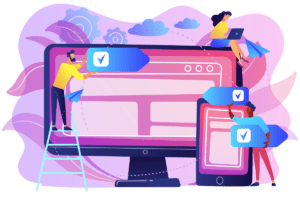Wouldn’t it be nice if you could close every deal, win over every customer all without having to deal with any sales objections? In a perfect world, prospects would all be itching to buy your offer, pocketbook in hand. Encountering sales objections is part of the game, so it’s best to brush up on your skills to land as many wins as possible. In this guide, we’re covering the four types of common sales objections you’re likely to encounter, plus 7 tactics for how to navigate them like a pro.
The 4 Types of Sales Objections
While there are many different kinds of sales objections, most of them fall into one of four categories: Price/Risk, Quality, Trust, or Stall.
Categorizing the sales objections you encounter will help you better identify which tactics to use to address them, as well as tally the most common objections you see in your business.
Price/Risk
The most common sales objections usually have to do with price, cost, or ROI (return on investment) concerns from the prospect.
Perhaps they’re not sure whether your offer/service is within their budget, they’re unsure of whether they will see a tangible return, or they think the cost is far too high. When you think about it, most of these objections are about risk; they’re nervous about paying X amount and not seeing anything to show for it.
As a sales professional, your goal should be to highlight the value of your offer and make it uber clear what the return will be. You can also work on building trust with the customer so they feel reassured and confident in your offer.
Quality
Sometimes customers have doubts about the quality of a brand’s service or product. They may also express doubts about the experience of your staff, the speed of service, the availability of your customer service team, etc. All of these objections have to do with quality of service.
Trust
While we’d argue that most sales objections have to do with trust, there are a few that involve directly questioning the trustworthiness and credibility of your business/service/product. In these cases, you should work to establish a better relationship with your customers to build some rapport and make them more likely to trust your offer.
Stall
Have you ever had a customer say that they need to “think about it” and “will get back to you”? This is an example of a stall. A customer may stall for a variety of reasons. Your job is to uncover why they feel like they need more time to decide and then address any questions/concerns they may have.
Additionally, many customers stall when they feel too much pressure or anxiety around the close. You may want to take your foot off the gas a bit to better understand their hesitation and give them some time to come around.

7 Sales Objection Handling Tactics
If you have anticipated (and prepared for) the four types of objections, you’ll be ready to handle anything that comes your way. Just remember that the customer has very valid reasons for their objections and each concern should be handled with care. In most cases, it comes down to trust, reassurance, and confidence.
Here are 7 effective tactics for addressing the most common sales objections so you can increase your close rate and create more happy customers.
1. Reframing
One of the best ways to handle sales objections is the redirect the customer’s focus back to the bigger picture of why the purchase is important.
This involves reframing the objection and relating it back to their reason for buying. With this tactic, you essentially bring up the benefits of the product/service, position these against any deficits, and then answer questions they may have about your offer.
Reframing has four parts:
- 1. Question the customer’s reasoning and determine their emotional state. (ex. “What concerns you about the quality of our product?”)
- 2. Minimize the objection by reframing their doubts using closed questions like: “So you feel like you need more time. Have you considered the financial costs of purchasing this product later versus now?”
- 3. Compare the risks and benefits for them. (ex. “What we offer is a custom-tailored solution that will increase efficiency in your business, streamline communications, and remove costly bottlenecks.”)
- 4. Question their perspective using closed questions (ex. “Do you feel that this custom solution will help your business become more efficient? Will that be of value to your company?”)
Once the customer understands the value you’re offering and has agreed that it’s worth the risk of their investment, you have successfully handled the objection and can close the deal.
2. Express Gratitude
Being on the customer end of a sales call can be stressful. They may not know you, may not even know your product, and are likely to have several questions about your offer. Sometimes all it takes to put a customer at ease is to express gratitude for their time and consideration.
First, thank the customer for taking the time out of their schedule to have a call with you. Reassure them that you are here to answer any questions they may have and that you’re committed to providing the best solution for them. The call serves as a way for you to get to know each other.
Next, thank them every time they present you with an objection. This shows that you are receptive to their concerns and are here to put their mind at ease. In fact, the more comfortable they are with presenting you with objections, the more opportunities you’ll have to reframe each one to your advantage.
An objection is better than a “no” because it gives you the chance to have a conversation. Be sure that the customer feels this is a safe space for them to express their concerns without hostility or judgment.
3. Empathize with Their Situation
As a sales representative, you may feel like you’re in the driver’s seat when it comes to the sales conversation, and in fact this makes it even more important that you empathize with the customer’s position and perspective. The more committed you are to understanding the customer’s objections, the better prepared you will be to handle them like a boss.
Empathy helps you connect with your customer, show them you care, and prove that you’re listening to what they have to say. After thanking the customer for bringing up the objection, express empathy to further diffuse the situation.
For example, you can say: “I completely understand where you are coming from. That sounds very frustrating. I think I have an idea that could help”¦”.
4. Clarify with Questions
Sometimes an objection arises due to a miscommunication between you and the customer, or a misunderstanding of an original objection. If there is any confusion around what a customer means, it’s your job to ask clarifying questions to better understand their perspective.
Some examples of clarifying questions include:
- “I hear you say that your main concern is the cost. Are you worried about the initial expense or rather the potential return on your investment?”
- “You said that you aren’t sure this is the right product for you. What do you feel like this product is missing for you?”
- “Our product increases productivity in your business but I hear you say that you are looking to increase efficiency as well. In what ways would you like to see your business become more efficient?”
- “I understand your desire for more time to think about whether this service is right for you. Do you feel like you need more time due to budget constraints or something else?”
Do your best to get to the root of the customer’s objection by asking clarifying questions. Next, confirm their answer to ensure that you are both on the same page. Then you can move forward in the sales process.
5. Show the Value
Remember that many of the most common objections have to do with price and risk. Essentially, these customers are questioning the value of your offer. This may include the monetary value but most often this has to do with the potential return on their investment. Your goal is to highlight the value of your offer so the benefits are obvious.
Here are a few different ways to communicate the value of your offer:
- Explain the financial return they can expect from their investment
- Detail any savings they may expect as a result of using this product/service
- Explain the opportunity costs of NOT buying this service/product (example: fewer leads and less revenue)
- Communicate the personal or lifestyle benefits of your offer (examples: clarity, less stress, peace of mind, confidence, etc.)
- Provide proof of the results you’ve generated for past customers
Further, you can ask customers if they’re looking for a specific type of value and then position your offer as satisfying what they’re looking for (assuming it does). There may be many ways to position your product/offer in terms of generating ROI, bringing X benefit, saving Y value in business expenses, saving time and increasing efficiency, etc.

6. Tell a Story
Often times a customer needs to be able to envision their life with the product or service in order to visualize whether this is the right solution for them. As a sales representative, you can paint this picture for them using storytelling and by comparing different scenarios.
To do this, first gain an understanding of their current situation. You can paint this picture for them based on the details they have provided.
Example: “Right now, you have a 7-figure business that has hit a plateau due to inefficiencies between team members. Your current project management tool is cumbersome and creates bottlenecks in your system. You’re frustrated and know this is costing you money.”
Next, tell the story of how their life or business will look different after the purchase. This may be hypothetical, but you want it to be as realistic as possible so they trust this outcome and can picture it for themselves.
Example: “Now envision what it would look like if all those bottlenecks went away. You create tasks in your project management tool, check project status, and tick it off once completed. Team members can easily share files across departments. This saves you time and allows you to tackle more projects, leading to more revenue in your business.”
What you’ve done is create what marketers call a “Heaven and Hell” situation. You have effectively compared their current situation (“hell”) to their desired outcome (“heaven”) with your offer as the obvious solution. That’s the power of storytelling.
7. Provide Social Proof and References
Finally, one great way to build trust and communicate value is to provide social proof and references that showcase the results you’ve generated for past customers. Some examples of social proof include:
- Screenshots of customer praise on social media
- Customer reviews and testimonials
- Case studies
- White papers
- References for prospects to contact
- Analytics/results
- Video testimonials
Having these on-hand will do most of the heavy lifting when it comes to proving that your product/service provides what it says it does. If the customer sees other people raving about your brand, they’ll be more likely to hop on board.
Bonus Tip: Use a Demo Software
A demo software is one of the newest sales technologies out there for B2B companies. Just like the name implies, a demo software can help you optimize your demo experience, which may make your sales objections a little easier to manage. Demowell is my favorite demo software, and it can help you create interactive and personalized demos for your clients and prospects. Or, you can choose to embed the interactive demo on your website to give your visitors a one-of-a-kind experience on your site. To learn more about demo software, check out this article.
Handle Sales Objections Like a Boss
Now that you’re aware of the most common types of sales objections and how to address them, you’ll be prepared for nearly any type of scenario. It does take practice to perfect the reframing/objection handling process, but, in time, you’ll be able to close more deals and create happier customers for your brand.
Want to generate warmer leads so landing more wins isn’t such a chore? Visitor Queue can provide the info you need to follow up with viable leads and close more deals. Start your free trial today.
 Identify
Identify Personalize
Personalize Benchmark
Benchmark Agencies
Agencies Integrations
Integrations Case Studies
Case Studies Use Cases
Use Cases Blog
Blog Resources
Resources









